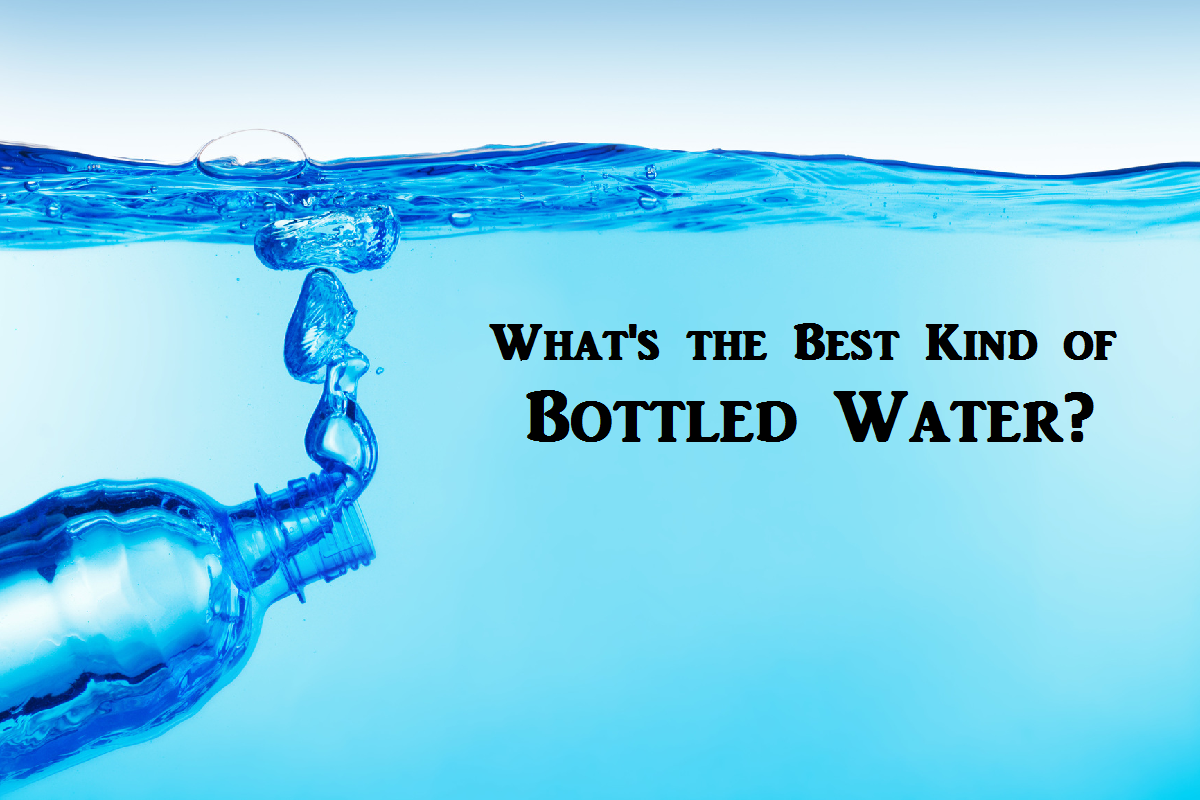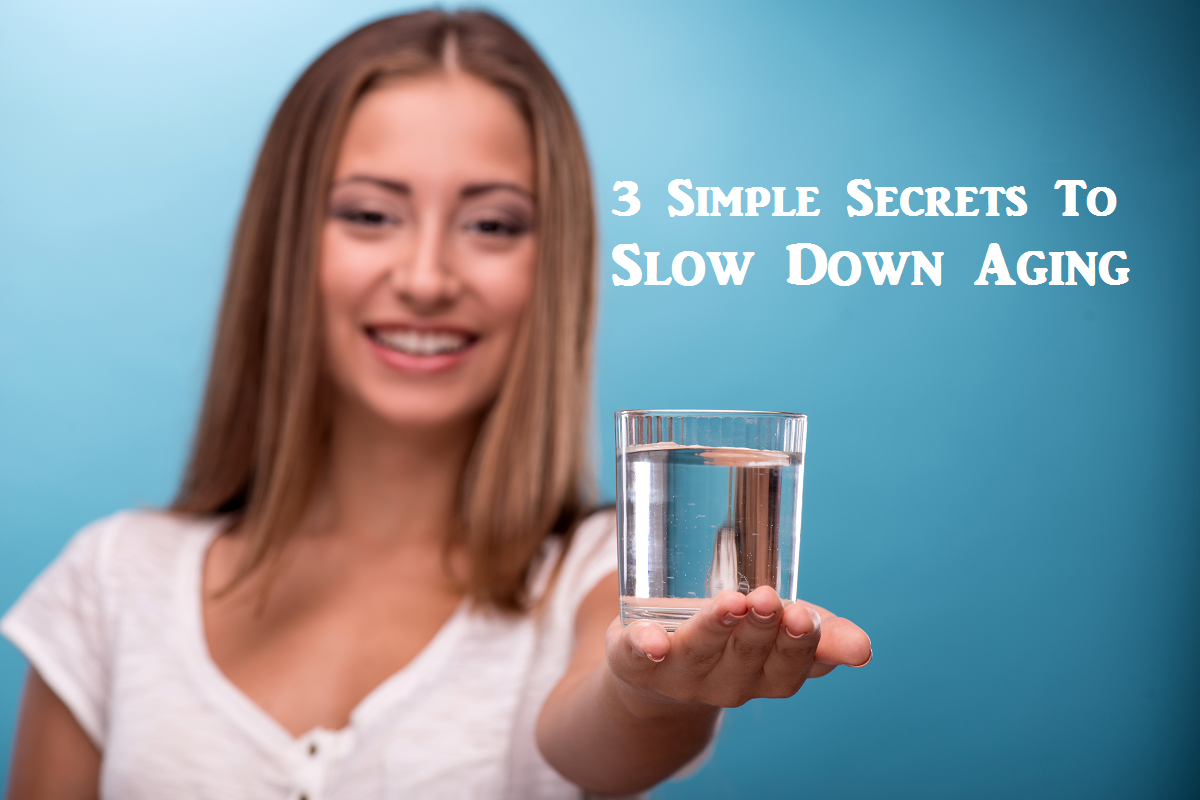Due to lead-poisoned water in Flint, Michigan (and in several other places), many of us are concerned about drinking water quality (1). We usually perceive bottled water to be better than tap or filtered water. However, studies have shown that our assumptions about bottled water are often not true (2,3). So this leads to the question, what’s the best kind of bottled water?
Bottled water quality can be variable across brands, water sources, types of bottles, bottling operations and storage conditions. Water quality at the source itself depends on many different factors, and therefore the “best” bottled water can be hard to define — it depends on the criteria that we use. So let’s approach our question based on four important considerations, that are based both on science and common sense.
Want a quick overview of this article? Here’s a 2 minute Video!
Or dive into the details below… and check out the data references at the bottom!
Consideration #1: Healthy Mineral Electrolytes versus Toxic Contaminants in Water
The best kind of bottled water has excellent water quality, and does not have toxic contaminants. However, it is not simply highly purified H2O, because good quality drinking water has healthy levels of mineral electrolytes, such as calcium and magnesium. These electrolytes improve drinking water taste and hydration, while contributing to daily intake of essential minerals that the body requires on a daily basis.
The presence of mineral electrolytes makes the water more hydrating, since the water with minerals is better absorbed into the body (that’s why sports drinks and oral rehydrating solutions always have mineral electrolytes). Mineralized water not only tastes better, it quenches thirst better and helps us function better. Many studies have shown improvements in physical, mental and daily functioning with improved hydration (4), and this is not just for athletes. Improved hydration helps everyone look, feel and perform better — children, teenagers, adults, as well as seniors.
Further, many epidemiological studies show that drinking mineral-rich “hard” water is associated with lower risks from cardiovascular disease (5). It’s worth noting here that cardiovascular disease is the leading cause of death in industrialized nations, including the United States. The evidence across a large number of scientific reports shows an overall consistent pattern — on one hand, many studies show health benefits from the presence of minerals in water (especially magnesium and calcium); and on the other hand many studies provide evidence that regular consumption of purified water without minerals increases health risks (6). It is interesting to note that the world’s most highly sought after natural healing and spa waters have always been rich in minerals.
Now, let’s consider bottled water quality with respect to toxic contaminants.
There have been many reports of toxic contaminants in bottled water, including coliform bacteria, arsenic, nitrates, trihalomethanes, and phthalates (2). Chemical contaminants usually come from the source water, while microbial contamination can be from the water or from unsanitary conditions in the bottling operations. Many underground aquifers and sources of spring water have become polluted over time with contaminants from agricultural runoff, and industrial activities (11, 12). An elevated level of nitrates, and/or the presence of artificial man-made chemicals in naturally sourced water are typical indicators of such contamination.
High quality, uncontaminated spring water, artesian water, or mineral water typically has less than 1 ppm (mg/L) of nitrates, and undetectable nitrites. It has extremely low or undetectable levels of toxic heavy metals (e.g. aluminum, antimony, cadmium, lead, mercury), synthetic organic chemicals (SOCs – this includes most pesticides and herbicides), or volatile organic chemicals (VOCs). Further, high quality bottled water from desirable natural sources has extremely low or undetectable levels of naturally occurring toxic contaminants such as arsenic, fluoride, and radioactivity.
If you regularly buy spring water (or any kind of bottled water), it’s always a good idea to check for the spring or water source on the bottle label, and then look through the water quality report for that source. For example, a given brand of bottled water may have five spring sources… look at the water quality report for the specific spring source mentioned on the label. The report should be available by visiting the company’s website, or by calling the phone number on the bottle label.
Here are some issues to look out for:
– spring source is not identified on the bottle label
– water quality report is not available, or is outdated (more than a year old)
– water quality report does not show a full list of test results along with FDA/EPA regulatory limits
– significant levels of one or more contaminants in the water quality report. For “high quality” bottled water, nitrates should be typically less than 1 ppm (mg/L). And ideally there should be undetectable levels of other toxic contaminants such as nitrites, arsenic, fluoride, radioactivity (e.g. radon, uranium etc), toxic metals (e.g. antimony, aluminum, cadmium, lead and mercury – usually all these are listed under “Inorganic Chemicals”), SOCs and VOCs (these may be listed under “Organic Chemicals” or under headings such as “Synthetic Chemicals”, “Volatile Organics”, “Pesticides & Herbicides” etc).
If any of the above contaminants are reported, compare the reported levels with the maximum permissible EPA/FDA regulatory limits (both test data and regulatory limits should be listed in the report). As a general rule of thumb, for “good quality” drinking water any contaminant should be at least 10-fold less than the regulatory limit. Why? Because the regulatory limits are typically established mainly based on practical and economic considerations of large scale water purification in water treatment plants and bottling operations, instead of strict health standards. As an example of this, the EPA limit for lead in tap water is 15 ppb (parts per billion), FDA limit for lead in bottled water is 5 ppb, and the official health-based target for lead in water is ZERO. Thus our rule of thumb with respect to lead contamination would be undetectable lead for high quality water, and less than 0.5 ppb lead for good quality water.
There is another, extremely common source of contamination for bottled water, and that’s the bottles and caps. Water packaged in plastic including the commonly used PET plastic) has varying levels of plasticizers that can have estrogenic and endocrine disrupting effects (7). In fact, even some types of glass bottles (or their caps / cap liners) can be a source of leachable impurities. Generally speaking though, the issue is more significant for plastic containers.
Many people drink purified bottled water, and some people even drink distilled bottled water with the assumption that such high purity waters must be better for consumption. There is a good reason for their popularity. These types of waters usually cost far less compared to most spring and mineral waters, which is a big plus point for cost-conscious shoppers. Of course there is a reason for the low cost — purified and distilled waters are typically sourced from the municipal (tap) water supply and are bottled into inexpensive plastic bottles after purification. The purification process is typically reverse-osmosis filtration for purified water, and vapor distillation for distilled water.
From a health perspective, there are two main issues with purified and distilled bottled waters. These waters have extremely low, or even undetectable levels of healthy mineral electrolytes. Secondly, these waters are also likely to have more leachable impurities, depending on the quality of bottles, and storage conditions. Any leachable plasticizers or other impurities migrate from the bottles into the water, because highly purified or distilled water is literally “hungry” to dissolve anything it can, and is aggressive in leaching out any soluble materials it comes into contact with.
For example, purified bottled water delivered to millions of offices and homes in 3 and 5 gallon blue tinted polycarbonate (PC) bottles is usually contaminated with endocrine-disrupting bisphenol-A (BPA) plasticizer, which leaches into the bottled water, and gets absorbed into our bodies upon drinking the water (8).
In fact, all types of plastic bottles (i.e. PET with recycling code #1, HDPE #2, PVC #3, LDPE #4, PP #5, PS #6, and other plastics including PC #7) have some leachables. Some plastics are known to be worse than others. It is best to avoid PVC #3, PS #6, and PC #7 plastic containers, particularly for any bottled water, beverages, or food. You can typically find these plastic codes on the bottom of each container.
Except for a commonly used phthalate plasticizer known as di-2-ethylhexyl-phthalate (DEHP), all the other leachable plasticizers (including BPA) are “unregulated”, so you will not find those listed in water quality reports. Thus there is no simple and reliable way for consumers to evaluate the level of plasticizers, or other types of leachables, in any kind of bottled water. Even for DEHP, if you see a very low or undetectable level in a water quality report, that’s the average level found at time of bottling… this does not mean that it did not leach into the water over time during storage.
Therefore, if you must buy bottled water, at least check what you can. Obtain and review the manufacturer’s water quality report for any type of bottled water that you regularly buy, whether purified, distilled, spring, artesian, or mineral water, and whether bottled in plastic or glass. Look for the “best by” or “expiry” date on the bottles, and certainly don’t leave those bottles in a location that experiences hot/cold temperature swings, for example, a parked car or garage.
Consideration #2: Environmental Waste
The best kind of bottled water does not generate mountains of toxic waste, and is kind to the environment. Surveys show that only about 12% of plastic bottles are recycled, and the rest contribute to litter and landfills… at the rate of tens of millions of bottles per day (9). Plastic water bottles generate toxic fumes and air pollution if incinerated. Otherwise, plastic bottles take up to 1000 years to biodegrade, accompanied with the release of plasticizers and degraded polymers into soil and water, thus adding to environmental pollution. In the big picture, practically every plastic bottle that we throw away adds to an accumulating environmental burden, with long term negative impact for future generations.
Consideration #3: Cost
The best kind of bottled water should not cost bags of money, and should be budget-friendly. In USA, drinking store-bought bottled water on a daily basis results in a cost that ranges from several hundred dollars to more than $2000 per year, for each adult in the family, just based on drinking water consumption! See cost details at 10A within the references below this article.
Consideration #4: Easy Accessibility
Getting the best kind of water should be easy on a day-to-day basis. It should not involve regular trips to stores, or hauling crates of bottles. From an accessibility perspective, as well as the prior 3 considerations, the best kind of bottled water is easily and FRESHLY BOTTLED AT HOME, IN A REUSABLE CONTAINER. The best reusable bottles are made of stainless steel or glass and last for years.
Overall, the “best” drinking water, whether bottled or not:
– is practically free of contaminants
– has healthy mineral electrolytes
– is kind to the environment
– is budget-friendly, and
– is easy accessible at home
So how can you regularly get this kind of water at home?
This is actually quite straightforward.
1. Use a reliable (preferably NSF-certified) water purification system at home, such as a reverse osmosis (RO) filter system, or a distillation system, and please change the filter cartridges on schedule. Since tap water has many different types of contaminants, it is essential to use a reliable filter system (with documented specifications) that broadly takes out or reduces all types of contaminants. In fact, there are about 90 contaminants that are regulated by the EPA, and literally hundreds of “unregulated” contaminants, many of which are carcinogenic (cancer-causing) or endocrine (hormone) disrupting chemicals. Even relatively low levels of such contaminants can cause health problems over time.
2. Use EMDROPS to add a few drops of healthy mineral electrolytes to the purified water when you fill your resuable bottle or cup of drinking water — and make it a habit to carry your high quality home-bottled water everywhere you go!
That’s it! By taking the above two steps, it is possible to have reliable and easy access to great quality water with healthy minerals. This kind of water does not have toxic contaminants, is easily accessible at home, and is much more environment-friendly and budget-friendly as compared to bottled water. See 10B within references for cost details; and see below for additional info about these two steps.
How to select a good, cost-effective filter, or how to check your existing filter system at home?
Small size home RO filter systems that combine RO and carbon filters, and fit under the kitchen sink are typically the most cost-effective. Insist on getting answers to the following 2 questions, along with the cost. A) Does this filter system remove or reduce all EPA regulated contaminants? B) If yes, what are the filter performance specifications? Steer clear of products that don’t provide answers to your satisfaction. Unfortunately, most types of home filters (including counter-top, faucet, fridge, and pitcher filters) do not pass this test. If your existing filter system at home checks out well on these two questions, congratulations!
What are the available options for adding healthy mineral electrolytes to purified water?
Compared to the large variety of filters, there are few products for adding healthy electrolytes into purified drinking water. EMDROPS is the only liquid electrolyte product that is a snap to use, and provides healthy levels of both calcium and magnesium, without any added sugars, calories, colors, or preservatives (13). A single drop is sufficient for one cup of water, and provides healthy mineral electrolytes at about 100 ppm (mg/L); and this can be easily increased to a higher level by adding more drops. No matter what type of product you choose (whether liquid or powder electrolytes, or mineralizing filters), insist on getting answers about their ingredients including additives & preservatives, along with specifications for the quantity of minerals added.
There are some additional commonly available options for adding electrolytes to drinking water. You can add a pinch of table salt, sea salt, or baking soda — all of these provide electrolytes (mainly sodium) when dissolved in water. Keep in mind though that most people already have excess sodium intake. If you prefer healthier calcium, magnesium and potassium electrolytes in your water to help maintain bone and cardiovascular (heart and arteries) health, EMDROPS provides those.
And what about regular bottled water, the kind that we buy?
There are times when our only choice may be to use store-bought bottled water, for example while traveling, or when fine dining. Are there ways to figure out in advance which bottled water brands are generally better, without spending hours of research on water quality reports? Yes there are.
You may find the following two resources helpful: A bottled water book authored by Michael Mascha (Fine Waters: A Connoiseur’s Guide to the World’s Most Distinctive Bottled Waters) has a useful compilation of the world’s best known natural bottled waters (11). It has lots of interesting information, including their geographical source, mineral content (e.g. calcium, magnesium etc) and water purity (this is based on nitrate levels; unfortunately other types of contaminants are not discussed).
Secondly, you can download and review this scientific journal review article — it has a literature compilation of many bottled water constituents, along with additional technical information (12). You may be in for a surprise when you find from these types of sources that even some of the premium brands of bottled water can have relatively high nitrate levels, indicating compromised purity.
In summary, the best kind of bottled water is that which you purify, mineralize and bottle at home, in a reusable glass or steel bottle. Water purification and mineralization can be done reliably and easily at home, in a cost-effective manner.
Cited References:
- Unsafe Lead Levels in Tap Water Not Limited to Flint. By Michael Wines and John Schwartz, The New York Times, Feb 8, 2016.
Quote: Contamination has turned up in scores of communities in recent years, and experts cite holes in the safety net of rules and procedures.
- Bottled Water – Pure Drink or Pure Hype? Chapter 3. Bottled Water Contamination: An Overview of NRDC’s and Others’ Surveys. Natural Resources Defence Council. Quote: NRDC undertook a four-year, detailed investigation to evaluate the quality of bottled water… What NRDC has found is in some cases reassuring and in others genuinely troubling… among the chemical contaminants of greatest potential concern in bottled water are volatile organic chemicals, arsenic, certain other inorganic chemicals, and plastic or plasticizing compounds.
- 2011 Bottled Water Scorecard. Environmental Working Group
Quote: A new EWG survey of 173 unique bottled water products finds a few improvements – but still too many secrets and too much advertising hype. Overall, 18 percent of bottled waters fail to list the location of their source, and 32 percent disclose nothing about the treatment or purity of the water.
- Riebl and Davy: The Hydration Equation: Update on Water Balance and Cognitive Performance. ACSMs Health Fit J. 2013 November/December; 17(6): 21–28
Quote: Water is a crucial nutrient and euhydration is necessary for optimal daily functioning.
- Catling, et al., A systematic review of analytical observational studies investigating the association between cardiovascular disease and drinking water hardness. Journal of Water and Health, 2008 Dec; 6(4): 433-42.
Quote: Of the nine case control studies, seven examined both drinking water magnesium and calcium and risk of death from cardiovascular disease. A pooled odds ratio showed a statistically significant inverse association between magnesium and cardiovascular mortality (OR 0.75 (95%CI 0.68, 0.82), p , 0.001). Only two studies reported a statistically significant effect for calcium.
- Health Risks from drinking demineralised water. Frantisek Kozisek, National Institute of Public Health (World Health Organization Report).
Quote: The possible adverse consequences of low mineral content water consumption are discussed in the following categories: • Direct effects on the intestinal mucous membrane, metabolism and mineral homeostasis or other body functions. • Little or no intake of calcium and magnesium from low-mineral water. • Low intake of other essential elements and microelements. • Loss of calcium, magnesium and other essential elements in prepared food. • Possible increased dietary intake of toxic metals.
- Martin Wagner, Jörg Oehlmann. Endocrine disruptors in bottled mineral water: Estrogenic activity in the E-Screen. Journal of Steroid Biochemistry & Molecular Biology 127 (2011) 128–135
Quote: Recently, we reported a broad contamination of commercially available bottled water with estrogenic activity and presented evidence for the plastic packaging being a source of this contamination… When comparing water of the same spring that is packed in glass or plastic bottles made of polyethylene terephthalate (PET), estrogenic activity is three times higher in water from plastic bottles.
- Jenny L. Carwile et al., Polycarbonate Bottle Use and Urinary Bisphenol A Concentrations. Environmental Health Perspectives 2009 Sep 117 (9): 1368–1372.
Quote: One week of polycarbonate bottle use increased urinary BPA concentrations by two-thirds. Regular consumption of cold beverages from polycarbonate bottles is associated with a substantial increase in urinary BPA concentrations irrespective of exposure to BPA from other sources.
- Plastic bottles pile up as mountains of waste – Americans’ thirst for portable water is behind the drop in recycling rate. By Miguel Llanos, NBCNEWS.com.
Quote: Only about 12 percent of “custom” plastic bottles, a category dominated by water, were recycled in 2003, according to industry consultant R.W. Beck, Inc. That’s 40 million bottles a day that went into the trash or became litter.
10A. Annual cost estimate for use of bottled drinking water in the United States is approx $350 at the low end, to easily more than $2000 per adult, based on an assumption of 8 cups of water consumption per day, per adult. Low price-point assumes buying 16.9 oz. bottles of generic purified water in plastic bottles, at a store or online price of approx. $6 per 24-pack (annual cost of about $345 per person). Medium price-point assumes buying 23.7 oz. bottles of branded electrolyte-enhanced smart water in plastic bottles, at a store or online price of approx $16 per 6-pack (annual cost of about $2600 per person). NOTE: These cost estimates do not include any sales tax, shipping / delivery charges for bottled water, any bottle recycling / CRV cost. The estimates do not include use of bottled water for any cooking or other household purposes – this will cost more. Use of premium natural mineral water in glass bottles will cost a lot more.
10B. Annual cost estimate for reverse-osmosis purified and mineralized water is approx $250 per adult, based on an assumption of 8 cups of water consumption per day per adult, in a household of two adults. This estimate assumes a Watts-Premier brand NSF-certified reverse osmosis (RO) filter system installed under kitchen sink, at a store or online price of approx $200, a one-time professional installation cost of approx $100, and an annual filter cartridge replacement cost of approx $70. Also assumes that the RO-purified water is mineralized at a level of about 100 ppm healthy electrolytes from EMDROPS, available online at price of approx $25 per bottle. Since this product is highly concentrated, each bottle can last up to 2.5 months for 2 adults. NOTE: These cost estimates do not include any sales tax, or cost of municipal water supply, since drinking water use is a very small fraction of water use in households. Apart from daily drinking water, the RO-purified water can (and should) be used for household cooking purposes; this does not involve any significant additional cost for the consumer.
- Fine Waters: A Connoiseur’s Guide to the World’s Most Distinctive Bottled Waters. By Michael Mascha (Quirk Books, 2006).
Book Blurb: Not all bottled water is created equal—but how do you differentiate natural, untreated waters from the thousands of processed waters? This illustrated companion reveals the epicurean pleasures of water and shows you how to select bottled waters that will tempt your palate.
- Diduch M , Polkowska Z, Namieśnik J. Chemical quality of bottled waters: a review. J Food Sci. 2011 Nov-Dec;76(9): R178-96.
Quote: Bottled waters are a special case, because apart from organic contamination from the environment, the water may become secondarily contaminated as a result of its being improperly transported and stored. Pesticides, volatile organic compounds, and carbonyl compounds have been detected in samples of bottled water. This overview shows the available published information on levels of inorganic constituents and organic contaminants in samples of bottled water in the context of sample preparation procedures and analytical techniques. - EMDROPS Overview Information. By Watermins.










Leave A Comment